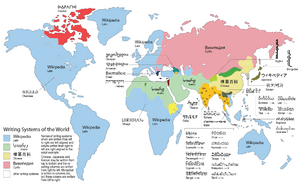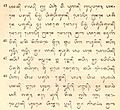Writing system facts for kids
A writing system is a special way to write down a language. It uses symbols to show words, sounds, or ideas. Think of it like a code that lets us read and write.
There are different kinds of writing systems. Each type uses symbols in a unique way. Some symbols stand for whole words, some for parts of words (like syllables), and others for single sounds. Besides the writing systems that grew naturally, people have also made up their own constructed scripts.
Contents
Logographic Systems
A logographic system uses symbols that stand for whole words or ideas. These symbols are called logograms. For example, in some ancient writing systems, a picture of a sun might mean "sun."
The Chinese language uses a logographic system. Each character often represents a whole word or concept. Ancient hieroglyphs also used logograms. However, even these systems use logograms only part of the time.
Syllabaries
A syllabary is a writing system where each symbol stands for a whole syllable. A syllable is a part of a word, like "ba" or "na."
For example, the Japanese language uses two syllabaries called hiragana and katakana. The Cherokee syllabary is another example. It was created for the Cherokee language. Each symbol in a syllabary helps you sound out a part of a word.
Alphabets
Alphabets are writing systems where symbols stand for individual sounds. These sounds are called phonemes. This is different from logograms (whole words) or syllabary symbols (syllables).
True Alphabets
A true alphabet has symbols for all kinds of single sounds. This includes both consonants and vowels. The alphabet you are reading right now is a true alphabet!
The Roman alphabet is used in many parts of the world. The Greek alphabet is used in Greece and Cyprus. The Cyrillic alphabet is used in many countries in Eastern Europe and Central Asia. This is because Russia had a big influence there in the past.
Abjads
Some alphabets only show consonants. They do not have symbols for vowels. These are called abjads. You have to guess or know which vowel sound goes with the consonant.
The Arabic alphabet is an abjad. It is used in many Muslim countries. The Hebrew alphabet is also an abjad. It is used for Jewish languages like Hebrew and Yiddish. Both Arabic and Hebrew abjads are written from right to left.
Abugidas
Abugidas are special alphabets. In an abugida, a consonant and a vowel are often written together as one unit. The main letter is for the consonant. If no other vowel is written, a specific vowel sound is usually understood.
Many writing systems in India and Southeast Asia are abugidas. For example, Devanagari is an abugida used for Hindi and Sanskrit.
Related pages
Images for kids
-
A Specimen of typefaces and styles, by William Caslon, a letter maker; from the 1728 Cyclopaedia
-
How writing changed from pictures to more abstract shapes in Mesopotamian cuneiforms, Egyptian hieroglyphs, and Chinese characters.
-
A table of different writing styles from the introduction to a Sanskrit-English Dictionary by Monier Monier-Williams
-
A stop sign in both English and the Cherokee syllabary in Tahlequah, Oklahoma. This is an example of bilingual writing.
See also
 In Spanish: Sistema de escritura para niños
In Spanish: Sistema de escritura para niños







